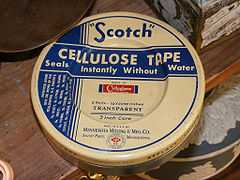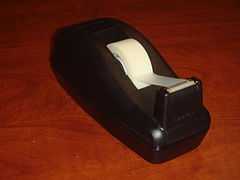Scotch Tape
 A modern roll of Scotch Box sealing tape | |
| Product type | Pressure-sensitive tape |
|---|---|
| Owner | 3M |
| Country | Minneapolis, Minnesota, U.S. |
| Introduced | 1930 |
| Website | scotchtape.com |
Scotch Tape is a brand name used for certain pressure-sensitive tapes manufactured by 3M as part of the company's Scotch brand.


History
The precursor to the current tapes was developed in the 1930s in Minneapolis, Minnesota by Richard Drew to seal a then-new transparent material known as cellophane.[1]
Trade names
Although it is a trademarked brand name, Scotch tape is commonly used in the United States, Canada, Italy, Russia, Ukraine and elsewhere as a generic term for transparent adhesive tape. (The Irish, New Zealand, South Africa and UK equivalent of Scotch tape is Sellotape. The Australian term is sticky tape) The Scotch brand includes many different constructions (backings, adhesives, etc.) and colors of tape.
The use of the term Scotch in the name was a pejorative meaning "stingy" in the 1920s and 1930s. The brandname Scotch came about around 1925 while Richard Drew was testing his first masking tape to determine how much adhesive he needed to add. The bodyshop painter became frustrated with the sample masking tape and exclaimed, "Take this tape back to those Scotch bosses of yours and tell them to put more adhesive on it!"[2][3] The name was soon applied to the entire line of 3M tapes.
Scotty McTape, a kilt-wearing cartoon boy, was the brand's mascot for two decades, first appearing in 1944.[4] The familiar tartan design, a take on the well-known Wallace tartan, was introduced in 1945.[4]
The Scotch brand and Scotch Tape are registered trademarks of 3M. Besides using Scotch as a prefix in its brand names (Scotchgard, Scotchlite, and Scotch-Brite), the company also used the Scotch name for its (mainly professional) audiovisual magnetic tape products, until the early 1990s when the tapes were branded solely with the 3M logo.[5] In 1996, 3M exited the magnetic tape business, selling its assets to Quantegy (which is a spin-off of Ampex).

X-rays
In 1953, Soviet scientists showed that triboluminescence caused by peeling a roll of an unidentified Scotch brand tape in a vacuum can produce X-rays.[6] In 2008, American scientists performed an experiment that showed the rays can be strong enough to leave an X-ray image of a finger on photographic paper.[7]
See also
References
- ↑ "Scotch US - History of Scotch Brand - From Tape to Tacky Glue, Laminator Machines and more". 3m.com. Retrieved 2010-03-28.
- ↑ "Inventor of the Week: Archive". Web.mit.edu. Retrieved 2013-07-18.
- ↑ Bellis, Mary. "The History of Scotch Tape". About.com. Retrieved January 25, 2013.
- ↑ 4.0 4.1 "Scotch 75th Anniversary - The Tale of the Tape - Mad about Plaid". 3m.com. Retrieved 2010-03-28.
- ↑ "The Use of Metal and Plastic Reels with "Scotch" Sound Recording Tape". Sound Talk. 3M. Retrieved 28 March 2010.
- ↑ Karasev, V. V., Krotova, N. A. & Deryagin, B. W. Study of electronic emission during the stripping of a layer of high polymer from glass in a vacuum. (in Russian) Dokl. Akad. Nauk. SSR 88, 777–780 (1953).
- ↑ Camara C. G., Escobar J. V., Hird J. R. and Putterman S. J., Correlation between nanosecond X-ray flashes and stick–slip friction in peeling tape, Nature 455, 1089-1092 (23 October 2008)
External links
| Look up scotch tape in Wiktionary, the free dictionary. |
- History of Cellophane Tape and the Scotch Brand
- Scotch 75th Anniversary — Pages with history information and old commercials featuring Scotty McTape
- Scotch-tape.co.uk — Official website for the UK
- Scotchtape.com — Official website for the USA
- Ambidextrousmag.org — A brief history of tape]